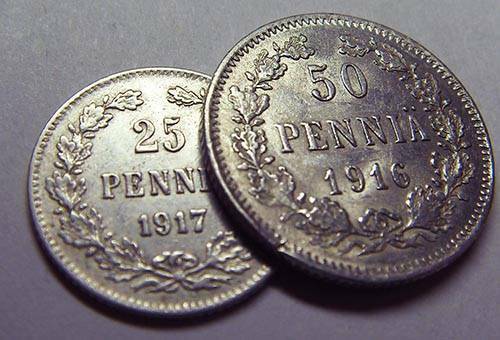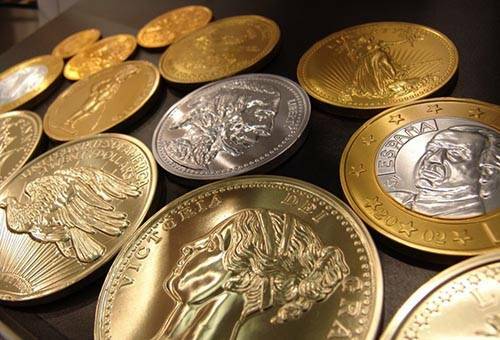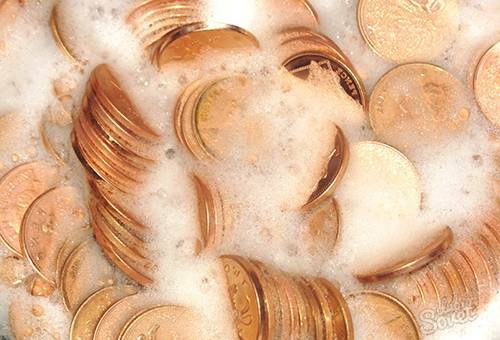Contents:
- Universal methods for cleaning coins
- Features of the approach to the processing of coins from different metals
- Additional types of cleaning old coins with the preservation of patina
Not only collectors, but ordinary people sometimes face the need to clean coins from rust to give them a more presentable appearance. Cleaning coins at home is simple and affordable, you just need to follow the basic rules for performing technical manipulations. To ennoble old products from expensive metals coated with a dense layer of oxide, in the absence of proper experience it is better to turn to professionals. You can do this yourself, but first you have to understand the existing methods of exposure to various materials and choose the best tool.

Universal cleaning methods for coins
All options for cleaning the coins are conventionally divided into four groups: chemical and mechanical effects, cooking, electrolysis. These directions are selected depending on the nature and intensity of pollution, the type of metal being processed, the desired result.
How to clean coins with chemical reagents?
- As solvents of oxide and other undesirable deposits, ammonia, soda, soap, detergent may be used. A good result results in exposure to vinegar, citric acid or hydrochloric acid. True, the last resort should be used very carefully. To do this, use a special bath, which is filled with the composition and immersed there objects. After that, the treatment with alkali is carried out without fail to neutralize the reaction.
- To remove dirt from most coins, you can use a soapy solution. For example, if you need to clean 10 rubles from a minor plaque, you just need to immerse the object in a solution of soap and warm water for 2-3 hours. This technique is suitable even for bimetallic copies of 10 rubles, which are quite demanding on the approach. In the case of an abundant coating, you just need to extend the exposure time to a day. To fix the gloss, clean coins are washed with a dishwashing detergent.
- Alkaline cleaning. In this way, copper coins or specimens from silver can be cleaned, but only low samples. Soda should be simply diluted with a small amount of water before the formation of gruel, which is applied to the coin. After a few minutes, the remedy starts working, and you can start to work on the surface with a soft brush.
- Effects of citric acid and vinegar. Variant for hard metals, often used for coins and products made of bronze, steel. It is able to get rid of the most resistant rust and dense salt spray. Preparing a bath of citric acid and soda, which drops the coin. Aggressive component can be replaced with vinegar. Before processing valuable items, it is recommended to check the concentration of the product, you can put 10 rubles into it and look at the result. If nothing terrible has happened, we proceed to processing.
Council
Pretty aggressive treatment options with vinegar and citric acid are not recommended for products made of precious metals. Gold, silver and even copper can change color under their influence.

- Treatment with ammonia .With the help of this reagent, silver coins, copper and its alloys are often cleaned. You just need to put the product in a clean product and check the quality of the impact after a while. If necessary, the approach is repeated. It is important to take into account the specifics of working with ammonia and make sure that the room is well ventilated.
- The most dangerous, but very effective approach is electrolysis. A coin under a layer of rust or dirt is placed in a slightly salted solution, where an electric current is supplied. Even the most resistant dirt can be removed for a period of time from half an hour to 3-4 hours, but it is better to leave the technique to professionals.
- Machining. Pollution is removed using special tools. Brushes, cuts of tissue, scalpels, needles and even drills can be used. This approach allows you to get rid of any dirt, but there is a risk of damage to the surface of the object. To begin with, you have to work out the necessary skills, for this it is recommended to practice on a less expensive coin, for example, 10 rubles.
- Digestion. Products are placed in boiling olive or petrolatum oil for 10 minutes, then washed with water and soap and processed with a brush. At the end of the approach, the coins are boiled in distilled water.

Features of the approach to the processing of coins from different metals
Cleaning of gold coins should not be aggressive. It should be ensured that the process does not suffer embossing on the surface of the product. The best option is treating items with a warm soapy solution. It is worth considering that even the treatment with a cloth can cause the appearance of small scratches on the surface of the metal.
Cleaning of silver coins begins with an assessment of the quality of the product, installation of the sample. Items of high quality can be cleaned with a weak solution of ammonia, while allowing boiling and applying a soft brush. Minor local oxidations are removed with a mixture of toothpaste, ammonia and soda. Greenish silver coins of low quality are treated with a solution of Trilon B.
Aggressive cleaning of copper coins from traces of oxidation, dirt and rust is carried out only if there is corrosion on the surface. To eliminate a dense layer, processing with citric acid or vinegar is permissible, but the effect should be local and very accurate. Before cleaning copper coins, they must be washed in a soap solution, this will eliminate the layer of fat.
Aluminum products are coated with plaque to protect against permanent oxidation. Cleaning of aluminum coins is carried out only if they need to be sold or put up. In this case, you can use ammonia, borax or a very weak solution of citric acid.
When cleaning products made of bronze, you need to consider that the metal can change its color brown and even black under the influence of ammonia. With the help of toothpaste, you can restore the shine to bronze, you just need to rub the surface of the product lightly and wash it off with warm water. Drying of processed bronze products is carried out in soft cloth or paper napkins, otherwise the metal will fade.

Additional types of cleaning of old coins with preservation of patina
The most reasonable variant of the approach in this case is the reference to a professional. Incorrect actions are capable, together with traces of oxide, to remove the patina so valuable on old coins. If cleaning is still carried out at home, it is worth trying one of the following options.
- Bath from laundry soap. We pour boiling water into a plastic bathtub, pour the frayed brown laundry soap and wait until the composition thickens. Then we put coins in it and leave for a day or even two. Then remove the items and wipe them with a soft cloth. Repeat if necessary.
- Bath from sodium hydroxide. A sachet of sachet is dissolved in half a liter of cold distilled water. We place it in the coin with tweezers. Cleaning takes no more than 10 minutes. Then the objects are removed and washed in water.
The cleaning process will have to be constantly monitored so as not to spoil the product. React to any unexpected changes in the working surface. For example, if the traces of oxide change color sharply and become blue or green, it is better to interrupt the manipulation, rinse the object and turn to specialists.



